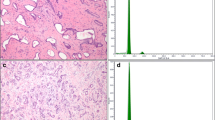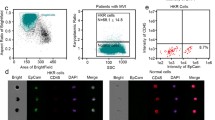Abstract
This study aims to evaluate the clinical significance of the nuclear DNA index (DI) for identification of multicentrically occurring (MC) hepatocellular carcinoma (HCC). In 14 multinodular HCC patients, the DI of 30 HCC specimens and 14 non-cancerous liver tissues were analyzed by flow cytometry. Histological studies of the 30 HCCs revealed MC in 6 cases and intrahepatic metastasis (IM) in 7 cases except for a histologically undetermined case who was found to be a hepatitis B virus (HBV) carrier, and the MC of this case was determined by a clonal study using the HBV integration pattern. In four of the seven specimens with MC HCC, the DI of all the intrahepatic tumors was 1.0 (diploid pattern), while the remaining three were different. On the other hand, five of the seven IM cases were identical (3 diploid and 2 aneuploid), one similar level (DI = 1.17 – 1.18) and one different (1.0 and 1.24). Moreover, in one IM case, the possibility of an alteration of the DI during the course of HCC development was investigated. Although the DI of the recurrent main tumor (DI = 1.17) of this case, which was identified as metastasis of the primary tumor by a clonal study, was also similar to that of subsequent metastatic lesions (DI = 1.18), the DI of the primary tumor was 1.0. These results indicate that DI analysis was not enough to make a differential diagnosis of the multicentric occurrence of HCC.
Similar content being viewed by others
References
Sakamoto M, Hirohashi S, Tsuda H, Shimosato Y, Makuuchi M, Hosoda Y (1989) Multicentric independent development of hepatocellular carcinoma revealed by analysis of hepatitis B virus integration pattern. Am J Surg Pathol 13:1064–1067
Hsu HC, Chiou TJ, Chen JY, Lee CS, Peng SY (1991) Clonality and clonal evolution of hepatocellular carcinoma with multiple nodules. Hepatology 13:923–928
Matsuda M, Yamamoto M, Nagahori K, Miura K, Matsumoto Y (1991) Histopathological analysis of intrahepatic multiple hepatocellular carcinomas — possibility of differential diagnosis of their origins by clonal study. Yamanashi Med J 6:193–206
Esumi M, Aritaka T, Arii M, Suzuki K, Tanikawa K, Mizuo H, Mima T, Shikata T (1986) Clonal origin of human hepatoma determined by integration of hepatitis B virus DNA. Cancer Res 46:5767–5771
Esumi M, Tanaka Y, Tozuka S, Shikata T (1989) Clonal state of human hepatocellular carcinoma and non-tumor hapatocytes. Cancer Chemother Pharmacol 23(Suppl):S1-S3
Tsuda H, Hirohashi S, Shimosato Y, Terada M, Hasegawa H (1988) Clonal origin of atypical adenomatous hyperplasia of the liver and clonal identity with hepatocellular carcinoma. Gastroenterology 95:1664–1666
Chen PJ, Chen DS, Lai MY, Chang MH, Huang GT, Yang PM, Shen JC, Lee SC, Hsu HC, Sung JL (1989) Clonal origin of recurrent hepatocellular carcinomas. Gastroenterology 96:527–529
Frankfurt OS, Slocum HK, Rustum YM, Arbuck SG, Pavelic ZP, Petrelli N, Huben RP, Pontes EJ, Greco WR (1984) Flow cytometric analysis of DNA aneuploidy in primary and metastatic human solid tumors. Cytometry 5:71–80
Auer GU, Fallenius AG, Erhardt KY, Sundelin BSB (1984) Progression of mammary adenocarcinomas as reflected by nuclear DNA content. Cytometry 5:420–425
Kokal WA, Duda RB, Azumi N, Sheibani K, Kemeny MM, Terz JJ, Harada JR (1986) Tumor DNA content in primary and metastatic colorectal carcinoma. Arch Surg 121:1434–1439
Molenaar WM, Oosterhuis JW, Meiring A, Sleyfer DT, Koops HS, Cornelisse CJ (1986) Histology and DNA content of a secondary malignancy arising in a mature residual lesion 6 years after chemotherapy for a disseminated nonseminomatous testicular tumor. Cancer 58:264–268
Taylor SR, Roederer M, Murphy RF (1987) Flow cytometric DNA analysis of adrenocortical tumor in children. Cancer 59:2059–2063
Ishizu H (1989) Flow cytometric analysis of the DNA content of hepatocellular carcinoma. Jpn J Surg 19:662–673
Liver cancer study group of Japan (1992) The general rules for the clinical and pathological study of primary liver cancer, 3rd edn (in Japanese). Kanehara, Tokyo
Edmondson HA, Steiner PE (1954) Primary carcinoma of the liver: A study of 100 cases among 48,900 necropsies. Cancer 7:462–503
Kanai T, Hirohashi S, Shimosato Y (1987) Pathology of small hepatocellular carcinoma. Cancer 60:810–819
Sakamoto M, Hirohashi S, Shimosato Y (1991) Early stage of multiple hepatocarcinogenesis: Adenomatous hyperplasia and early hepatocellular carcinoma. Hum Pathol 22:172–178
Kenmochi K, Sugihara S, Kojiro M (1987) Relationship of histologic grade of hepatocellular carcinoma (HCC) to tumor size, and demonstration of tumor cells of multiple different grades in single small HCC. Liver 7:18–26
Southern EM (1975) Detection of specific sequences among DNA fragments separated by gel electrophoresis. J Mol Biol 98:503–517
Hedley DW, Friedlander ML, Taylor IW, Rugg CA, Musgrove EA (1983) Method for analysis of cellular DNA content of paraffin-embedded pathological material using flow cytometry. J Histochem Cytochem 31:1333–1335
Ishizu H, Uchino J, Une Y, Satoh N, Nojima T (1988) Ploidy pattern of nuclear DNA of hepatocellular carcinoma and its biological characteristics (in Japanese with English abstract). Kanzo (Acta Hepatol Japonica) 29:1078–1086
Fujimoto J, Okamoto E, Yamanaka N, Toyosaka A, Mitsunobu M (1991) Flow cytometric DNA analysis of hepatocellular carcinoma. Cancer 67:939–944
Ezaki T, Kanematsu T, Okamura T, Sonoda T, Sugimachi K (1988) DNA analysis of hepatocellular carcinoma and clinicopathological implications. Cancer 61:106–109
Cong WM, Wu MC (1990) The biopathologic aspect of DNA content of hepatocellular carcinoma. Cancer 66:498–458
Chin JL, Pontes JE, Frankfurt OS (1985) Flow cytometric deoxyribonucleic acid analysis of primary and metastatic human renal cell carcinoma. J Urol 133:582–585
Author information
Authors and Affiliations
Rights and permissions
About this article
Cite this article
Matsuda, M., Yamamoto, M. & Matsumoto, Y. An evaluation of the flow cytometric nuclear DNA analysis of intrahepatic multinodular hepatocellular carcinoma for a diagnosis of their multicentricity. Surg Today 24, 13–18 (1994). https://doi.org/10.1007/BF01676878
Received:
Accepted:
Issue Date:
DOI: https://doi.org/10.1007/BF01676878




